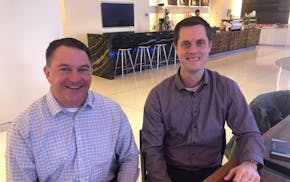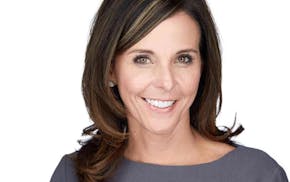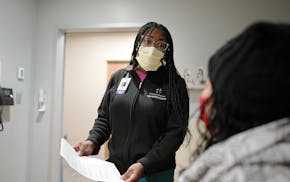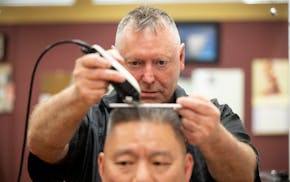The married team behind InstaTrim, conceived as a caulk substitute, is starting to seal success.
But this eight-year, hardscrabble journey is no get-rich-quick story.
After investing hundreds of thousands of dollars in mostly debt, Greg and Betsy Amundson, are breaking out in 2020 with their Minnesota-made, self-adhesive and flexible moldings for living spaces, bathrooms, equipment and elsewhere to gap and seal moisture, dirt and air infiltration.
Greg Amundson expects this to be the first full year of positive cash flow on revenue that surged to about $2.5 million, several times that of last year.
The surge stems from an economical, easy-to-handle product, a new marketing agency targeting online shoppers and COVID-sheltering property owners remodeling their homes.
Amundson is a 30-year custom homebuilder who exited the business after the 2008-09 recession.
"I still lay in bed some nights wondering what the hell I'm doing and wondering if it's worth it," said the candid business owner. "Years of cash-flow stress and dealing with e-commerce companies. Growth can be stressful."
Particularly when you start out thinly capitalized on what has been a long-haul journey. The tension has eased since Carl Bergquist, the Twin Cities industrialist, became a minority investor in InstaTrim.
That allowed the company to accelerate its online marketing effort. About 75% of sales are through Amazon. The Amundsons, who started out in their Scandia garage, have added a warehouse and distribution site and several employees.
The Amundsons are now paying themselves "minimal" salaries. Most of the cash goes back into the business in the quest for more business. That's right around the corner.
InstaTrim was selected by Walmart for a 100-store test in February.
"If we get accepted by Walmart, that's a big deal," Greg Amundson said. "It probably would double our business. That volume will require more cash, warehouse space and additional employees."
InstaTrim is a flexible, self-adhesive trim strip that can be used as a gap filler between walls and floor, as finish trim to tighten paint jobs or as a caulk replacement in the bathroom. Nothing sticks to old silicon caulk except silicon. So customers must cut it and clean it or the InstaTrim adhesive won't stick.
"We're not disrupting the caulking industry," Amundson said. "It's $50 billion. We're just the fire ant at its heels."
Watching closely is Gary Noble, founder of 20-year-old Bio-Plastic Solutions and a veteran contract manufacturer in Ellendale in southern Minnesota who first met with Amundson in 2013.
"Greg had unique idea when we first met," Noble recalled. "Most ideas fail.
"But we knew we could extrude what he was trying to do. We also get the adhesive on it, a liner and in the package. That costs. He's done it. Without going bankrupt."
Noble, who devotes four of 31 production workers to InstaTrim, was happy to extend terms that helped the Amundsons get through leaner times because he admired their creativity and grit.
It has become a good business line for Bio-Plastic He also was impressed with the investment by Bergquist, who grew and sold his own manufacturing company in 2015 for $570 million.
Now, InstaTrim and Bio-Plastic are ramping up again, for 2021 organic growth and Walmart.
Amundson said he wants the company to grow to $10 million in revenue over five years.
"I'm pretty confident that they can do this," Noble said. "I want to see them succeed."
Betsy Amundson is a marketer who once worked for 3M and Fallon. She used some of Bergquist's investment to retain the Stable, a Minneapolis-based marketer agency with a specialty in e-commerce, which the Amundsons credit with some of the 2020 sales increase.
Women buy 60% of InstaTrim. It is shipped on 1,000-kit pallets from Bio-Plastic to InstaTrim in Scandia for distribution.
Each kit has 10 or 20 feet of product that sells for $14.95 to $19.95. InstaTrim also sells bulk spools of up to 100 feet to contractors.
Amundson, 60, conceived of InstaTrim because he was frustrated with caulk, which can be lumpy, crooked and messy.
"It's not about getting rich," he said. "It's about proving that our idea is valid and solves problems and appeals to consumers. We're leaving most of the money in the business to grow the business.
"We've been at this for years and the end of 2019 into 2020 was the first period we made more than we spent. It was an eight-year net investment until then. We [invested] our savings, our retirement funds, borrowed against our house and borrowed from friends and family.''
Amundson also envisions a larger partner or buyer somewhere down the road.
"There was a point years ago where I would have taken $1 million for this business," Amundson said. "I don't think we would consider $5 million today. There are people looking for fast-growing companies. And I think we can be a $10 million company in three years.''

St. Anthony: 'Patient' investing paying off for St. Paul's Hill Capital

Jennifer Smith, leader of Burnsville's Innovative Office Solutions, has died

St. Anthony: Medical professions in Minnesota need more people of color in their ranks




